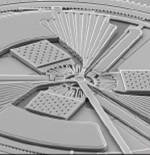

Research
Principles of Magnetism:
The key to understanding the workings of the micromotor involves understanding the principles of magnetism and rotational machinery. Magnetism and magnetic forces occur when a moving charge exerts a force on other moving charges. The magnetic force caused by these moving charges sets up a field which in turn exerts a force on other moving charges and is known as a magnetic field. Magnetic flux is a measure of the quantity of magnetism and takes into account the strength and extent of the magnetic field. The flux through an element of area perpendicular to the direction of magnetic field is given by the product of the magnetic flux density and the area of the element. The flux density is a response of a medium to the presence of a magnetic field.
Some materials can be said to be permanent or natural magnets (rotor part of the micromotor). These magnets do not appear to have any moving charge and therefore the magnetic fields are set up at the atomic scale. Electrons circling an atom create small magnetic fields. In most materials, these fields are aligned in a fairly random manner, so that all of these small fields cancel each other. In a magnet, however, these fields line up to create a net magnetic dipole, so that the object sets up a magnetic field in the surrounding space.
An electromagnet is a type of magnet in which the magnetic field is produced by a flow of electric current (stator part of the micromotor). When wire that is carrying electricity is coiled, the magnetic field becomes even stronger. Implementation of iron or steel objects as a magnetic flux carrier (iron core of the micromotor), surrounded by this coiled magnet wire will become magnetized and carry the same properties of permanent magnets including positive and negative poles and the ability to attract or repel other magnets.
The ability to alternately attract and repel other magnetic fields leads directly to the creation of an electromagnetic motor. As the electromagnets (stators) alternate between positive and negative polarity, they will attract the opposite pole permanent magnet (rotor) while they repel the preceding permanent magnet. This causes a shaft that is rigidly attached to the rotor to spin rapidly in one direction and allows the motor to perform work based on that motion.
The Picture Below Displays Various Magnetic Field Sources:
The Basics of MEMS:
Micro Electro Mechanical Systems is a term coined around 1989 to describe a research field that refers to mechanical components on the micrometer scale and describes the integration of mechanical elements, sensors, actuators, and electronics on a common silicon substrate through the machining process known as microfabrication. Microfabrication technology typically involves fabrication using planar processing such as surface micromachining and bulk micromachining. These fabrication techniques include silicon fabrication technology, molding and plating, wet etching, dry etching, electro discharge machining, and other technologies capable of manufacturing very small devices.

Thermal Actuator Optical Switch
Currently MEMS technology is mainly used for the purposes of miniaturization of current devices, the development of new devices based on principles that do not work on a larger scale, and the development of new tools to interact with the micro-world. Perceivably miniaturization would reduce cost since less material would be consumed. The decreased size would collaterally increase the applicability devices. The decrease of volume/surface ratio has profound implications for the design of MEMS. Actually it means that at a certain level of miniaturization, the surface effect will start to be dominant over the volume effects. Friction force (proportional to surface) will become larger than inertia (proportional to mass hence to volume), heat dissipation will become quicker and heat storage reduced. Essentially surface effects such as electrostatics and wetting dominate volume effects such as inertia or thermal mass.

Fully functioning transmission Complex Ratchet MechanismFurthermore, development of research tools such as atomic force and scanning near-field optical microscopes, have dramatically improved small scale research e.g., quantum mechanics. In essence the economic benefit of MEMS delivers parallel fabrication for mass production, package level integration, system level integration, and leverages IC fabrication technology. From a technical standpoint, the benefits of MEMS includes the ability of precision manufacturing, light weight and small size, novel capabilities, and material advantages.
The Images Below Describe the MEMS manufacturing scales and images of MEMS devices:
